High-Temperature Cyclic Oxidation Behavior and Microstructure Evolution of W- and Ce-Containing 18Cr-Mo Type Ferritic Stainless Steel
Abstract
:1. Introduction
2. Experimental
3. Results and Discussion
3.1. Initial Microstructure
3.2. Oxidation Kinetics
3.3. Surface Morphology of the Oxide Film
3.4. Cross-Sectional Morphology of Oxide Film
3.5. Strengthening Mechanism of W- and Ce-Containing Ferritic Stainless Steel
4. Conclusions
- (1)
- The addition of Ce and W significantly reduces the high-temperature cyclic oxidation rate of 444-type ferritic stainless steel. Ce oxides enhances the nucleation of Cr-Mn oxides, refining oxide particle size and stabilizing the oxide film against cracking and spalling.
- (2)
- The element Ce can promote the formation of the inner oxide film. The dense Cr2O3 oxide film can inhibit the diffusion of Mn3+ ions inside the oxide film and reduce the concentration of the Mn element in the oxide of the outer oxide layer. This change can promote the transformation of the outer oxide film from nodular-like oxides to spinel oxides with a better oxidation resistance. The Cr-Mn spinel oxide film can inhibit the diffusion of O2− ions and hinder the inward growth of the inner oxide film.
- (3)
- By promoting Laves phase precipitation at the oxide–matrix interface, which slows interfacial element diffusion and inhibits oxide film growth, W has a great influence on the oxidation behavior of ferritic stainless steel. However, an excessive content of W may result in the coarsening of the Laves phase over time, which could affect the adhesion between the film and the matrix if the phase grows excessively large.
Author Contributions
Funding
Institutional Review Board Statement
Informed Consent Statement
Data Availability Statement
Conflicts of Interest
References
- Froitzheim, J.; Meier, G.; Niewolak, L.; Ennis, P.; Hattendorf, H.; Singheiser, L.; Quadakkers, W. Development of high strength ferritic steel for interconnect application in SOFCs. J. Power Sources 2008, 178, 163–173. [Google Scholar] [CrossRef]
- Zhao, Y.; Liu, H.L.; Wei, L.L.; Chen, L.Q. An overview on the novel heat-resistant ferritic stainless steels. Tungsten 2023, 5, 467–480. [Google Scholar]
- Liu, H.L.; Wei, L.L.; Ma, M.Y.; Zheng, J.H.; Chen, L.Q.; Misra, R.D.K. Laves phase precipitation behavior and high-temperature strength of W-containing ferritic stainless steels. J. Mater. Res. Technol. 2020, 9, 2127–2135. [Google Scholar] [CrossRef]
- Liu, H.L.; Liu, L.L.; Ma, M.Y.; Chen, L.Q. Influence of finish rolling temperature on microstructure and mechanical properties of a 19Cr1.5Mo0.5W ferritic stainless steel. Acta Metall. Sin. 2020, 33, 991–1000. [Google Scholar] [CrossRef]
- Faivre, L.; Santacreu, P.O.; Acher, A. A new ferritic stainless steel with improved thermo-mechanical fatigue resistance for exhaust parts. Mater. High Temp. 2013, 30, 36–42. [Google Scholar] [CrossRef]
- Yun, D.W.; Seo, H.S.; Jun, J.H.; Lee, J.M.; Kim, D.H.; Kim, K.Y. Oxide modification by chi phase formed on oxide/metal interface of Fe-22Cr-0.5Mn ferritic stainless steel for SOFC interconnect. Int. J. Hydrogen Energy 2001, 36, 5595–5603. [Google Scholar] [CrossRef]
- Safikhani, A.; Aminfard, M. Effect of W and Ti addition on oxidation behavior and area-specific resistance of Fe-22Cr-0.5Mn ferritic stainless steel for SOFCs interconnect. Int. J. Hydrogen Energy 2014, 39, 2286–2296. [Google Scholar] [CrossRef]
- Wei, L.L.; Chen, L.Q.; Ma, M.Y.; Liu, H.L.; Misra, R.D.K. Oxidation behavior of ferritic stainless steels in simulated automotive exhaust gas containing 5 vol.% water vapor. Mater. Chem. Phys. 2018, 205, 508–517. [Google Scholar] [CrossRef]
- Ramanathan, L.V. Effect of rare earth elements on high temperature oxidation behaviour of austenitic steel. Corros. Sci. 2020, 164, 108359. [Google Scholar]
- Wei, L.L.; Zheng, J.H.; Chen, L.Q.; Misra, R.D.K. High temperature oxidation behavior of ferritic stainless steel containing W and Ce. Corros. Sci. 2018, 142, 79–92. [Google Scholar] [CrossRef]
- Ramanathan, L.V. Role of rare-earth elements on high temperature oxidation behavior of Fe-Cr, Ni-Cr, and Ni-Cr-Al alloy. Corros. Sci. 1993, 35, 871–878. [Google Scholar] [CrossRef]
- Li, X.; Shu, J.; Chen, L.Q.; Bi, H.Y. Effect of cerium on high-temperature oxidation resistance of 00Cr17NbTi ferritic stainless steel. Acta Metall. Sin. (Engl. Lett.) 2014, 27, 501–507. [Google Scholar] [CrossRef]
- Thanneeru, R.; Patil, S.; Deshpande, S.; Seal, S. Effect of trivalent rare earth dopants in nanocrystalline ceria coatings for high-temperature oxidation resistance. Acta Mater. 2007, 55, 3457–3466. [Google Scholar] [CrossRef]
- Silva, R.; Young, D.; Junior, C.M.; Vacchi, G.; Alberto, C.T.; Malafaia, A.D.S.; Pascal, C.; Rovere, C. Role of cerium addition in enhancing the oxidation resistance of austenitic Fe-Mn-Si-Cr-Ni shape memory stainless steels at 800 °C: Microstructure and oxidation mechanism. Corros. Sci. 2022, 209, 110788. [Google Scholar] [CrossRef]
- Alman, D.E.; Jablonski, P.D. Effect of minor elements and a Ce surface treatment on the oxidation behavior of an Fe-22Cr-0.5Mn (Crofer 22 APU) ferritic stainless steel. Int. J. Hydrogen Energy 2007, 32, 3743–3753. [Google Scholar] [CrossRef]
- You, P.F.; Zhang, X.; Zhang, H.L.; Liu, H.J.; Zeng, C.L. Effect of CeO2 on oxidation and electrical behaviors of ferritic stainless steel interconnects with Ni single bond Fe coatings. Int. J. Hydrogen Energy 2018, 43, 7492–7500. [Google Scholar] [CrossRef]
- Zheng, J.H.; Zhao, Y.; Chen, L.Q. High-temperature precipitation behavior of W-containing 444-type ferritic stainless steel in a simulated cyclic annealing process. J. Mater. Res. Technol. 2023, 22, 1712–1722. [Google Scholar] [CrossRef]
- Liu, H.L.; Ma, M.Y.; Liu, L.L.; Wei, L.L.; Chen, L.Q. Effect of W addition on hot deformation and precipitation behaviors of 19Cr2Mo ferritic stainless steel. J. Iron Steel Res. Int. 2019, 26, 425–434. [Google Scholar] [CrossRef]
- Ma, M.Y.; He, C.L.; Liu, H.L.; Chen, L.Q. Influence of cerium and tungsten addition on the passive behavior of 444-type ferritic stainless steels. Int. J. Electrochem. Sci. 2019, 14, 2277–2289. [Google Scholar] [CrossRef]
- Young, D.J. High Temperature Oxidation and Corrosion of Metals; Elsevier: Oxford, UK, 2008. [Google Scholar]
- Huntz, A.M. Parabolic laws during high temperature oxidation: Relations with the grain size and thickness of the oxide. J. Mater. Sci. Lett. 1999, 18, 1981–1984. [Google Scholar] [CrossRef]
- Talic, B.; Molin, S.; Hendriksen, P.V.; Lein, H.L. Effect of pre-oxidation on the oxidation resistance of Crofer 22 APU. Corros. Sci. 2018, 138, 189–199. [Google Scholar] [CrossRef]
- Bednarz, M.; Molin, S.; Bobruk, M.; Stygar, M.; Długoń, E.; Sitarz, M.; Brylewski, T. High-temperature oxidation of the Crofer 22 H ferritic steel with Mn1.45Co1.45Fe0.1O4 and Mn1.5Co1.5O4 spinel coatings under thermal cycling conditions and its properties. Mater. Chem. Phys. 2019, 225, 227–238. [Google Scholar] [CrossRef]
- Zhang, Y.; Zou, D.; Li, Y.; Wang, Y.; Zhang, W.; Zhang, X. Effect of Al content on the high-temperature oxidation behavior of 18Cr–Al–Si ferritic heat-resistant stainless steel. J. Mater. Res. Technol. 2021, 11, 1730–1740. [Google Scholar] [CrossRef]
- Salgado, M.D.F.; Carvalho, I.S.; Santos, R.S.; Porto, J.A.S.; Correa, O.; Ramanathan, L.; Brandim, A.D.S.; Lins, V.F. Effect of oxygen partial pressure on oxidation behavior of ferritic stainless steel AISI 441 at high temperatures. Eng. Fail. Anal. 2019, 105, 215–226. [Google Scholar] [CrossRef]
- Sabioni, A.C.S.; Huntz, A.M.; Borges, L.C.; Jomard, F. First study of manganese diffusion in Cr2O3 polycrystals and thin films by SIMS. Philos. Mag. 2007, 87, 1921–1937. [Google Scholar] [CrossRef]
- Huttunen-Saarivirta, E.; Kuokkala, V.T.; Pohjanne, P. Thermally grown oxide films and corrosion performance of ferritic stainless steels under simulated exhaust gas condensate conditions. Corros. Sci. 2014, 87, 344–365. [Google Scholar] [CrossRef]
- Shaigan, N.M.; Qu, W.; Ivey, D.G.; Chen, W.X. A review of recent progress in coatings, surface modifications and alloy developments for solid oxide fuel cell ferritic stainless-steel interconnects. J. Power Sources 2010, 195, 1529–1542. [Google Scholar] [CrossRef]
- Zhang, Y.B.; Zou, D.N.; Wang, X.Q.; Wang, Q.S.; Xu, R.; Zhang, W. Influences of Si content on the high-temperature oxidation behavior of X10CrAlSi18 ferritic heat-resistant stainless steel at 700 °C and 800 °C. Surf. Coat. Technol. 2021, 422, 127523. [Google Scholar] [CrossRef]
- Schmidt, D.; Galetz, M.C.; Schütze, M. Ferritic–martensitic steels: Improvement of the oxidation behavior in steam environments via diffusion coatings. Surf. Coat. Technol. 2013, 237, 23–29. [Google Scholar] [CrossRef]
- Ren, P.; Yang, Y.; Li, W.; Zhu, S.; Wang, F. Cyclic oxidation behavior of a multilayer composite coating for single-crystal superalloys. Corros. Sci. 2018, 145, 26–34. [Google Scholar] [CrossRef]
- Wagner, C. Theoretical analysis of the diffusion processes determining the oxidation rate of alloys. J. Electrochem. Soc. 1952, 99, 369–380. [Google Scholar] [CrossRef]
- Yang, L.; Lv, H.T.; Wan, C.L.; Gong, Q.M.; Chen, H.; Zhang, C.; Yang, Z.G. Review: Mechanism of Reactive Element Effect—Oxide Pegging. Acta Metall. Sin. 2021, 57, 182–190. [Google Scholar]
- Trindade, V.B.; Krupp, U.; Christ, H.-J. The influence of the rare earth element Ce on the high-temperature oxidation kinetics of low-Cr steels. J. Mater. Eng. Perform. 2008, 17, 915–919. [Google Scholar] [CrossRef]
- Safikhani, A.; Esmailian, M.; Tinatiseresht, T.; Darband, G.B. High temperature cyclic oxidation behavior of ferritic stainless steel with addition of alloying elements Nb and Ti for use in SOFCs interconnect. Int. J. Hydrogen Energy 2016, 41, 6045–6052. [Google Scholar] [CrossRef]
- Wei, L.L.; Chen, L.Q.; Liu, H.L.; Han, L.Q.; Gong, N.; Misra, R.D.K. Precipitation behavior of Laves phase in the vicinity of oxide film of ferritic stainless steel: Selective oxidation-induced precipitation. Oxid. Met. 2020, 93, 195–213. [Google Scholar] [CrossRef]



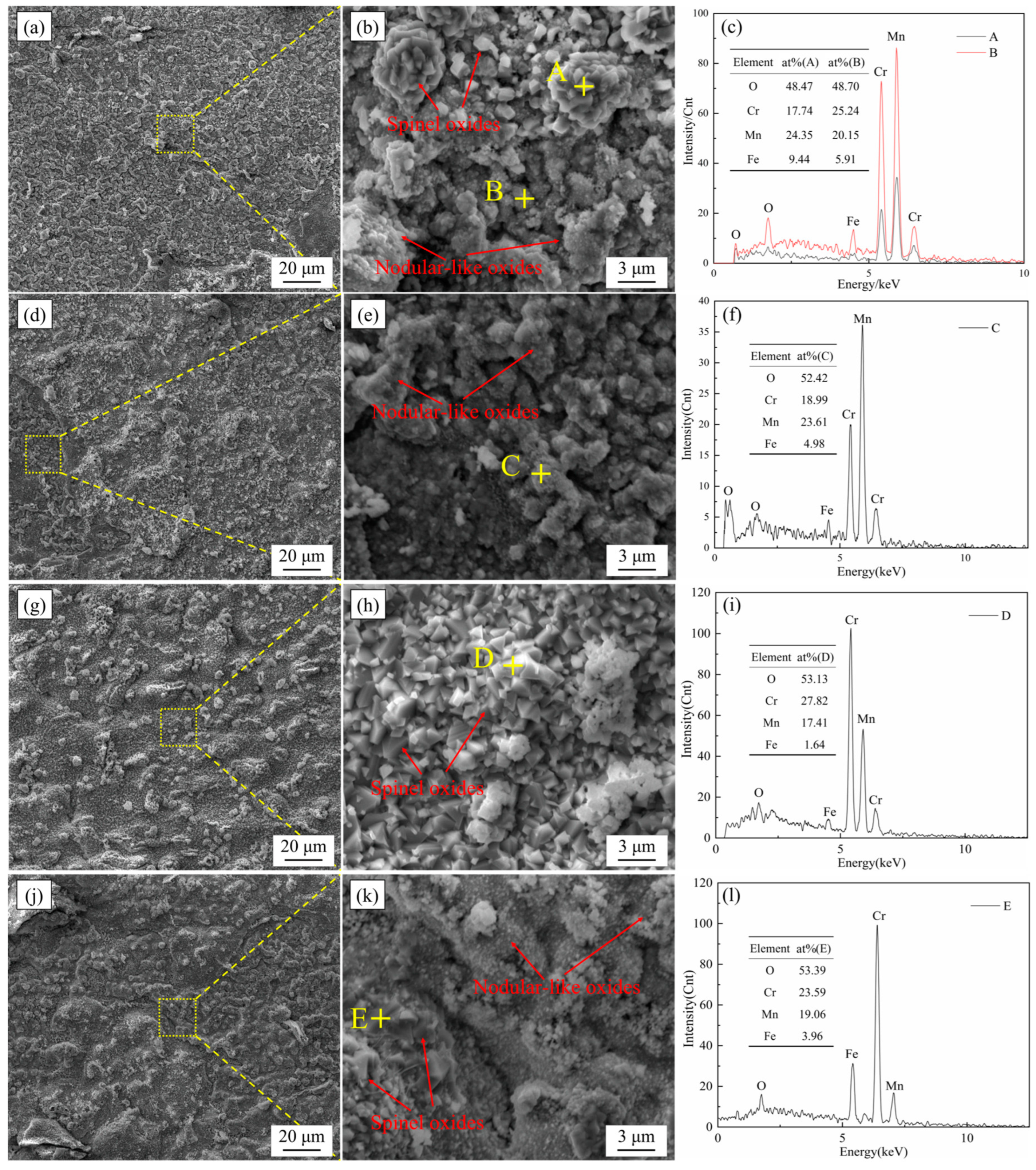



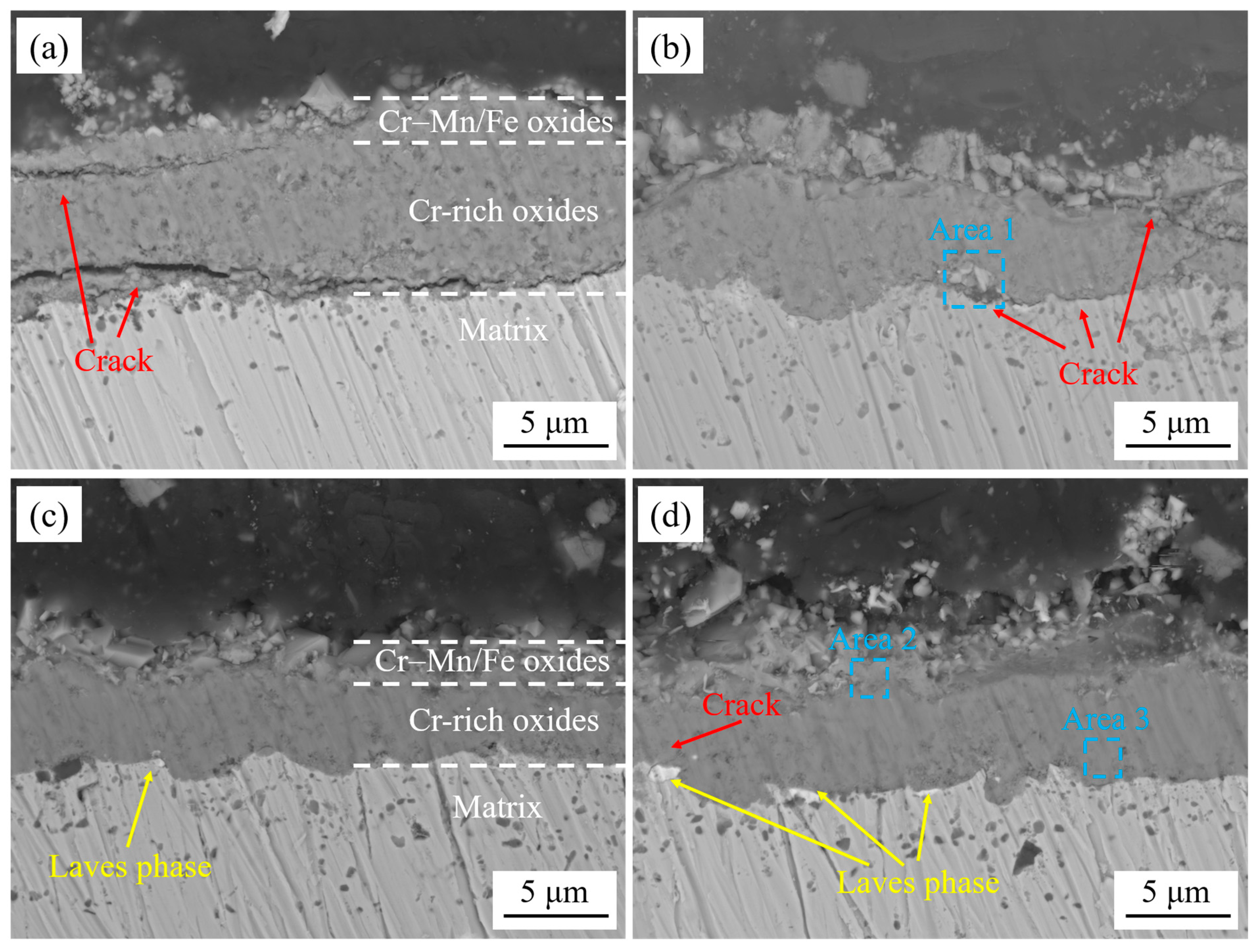

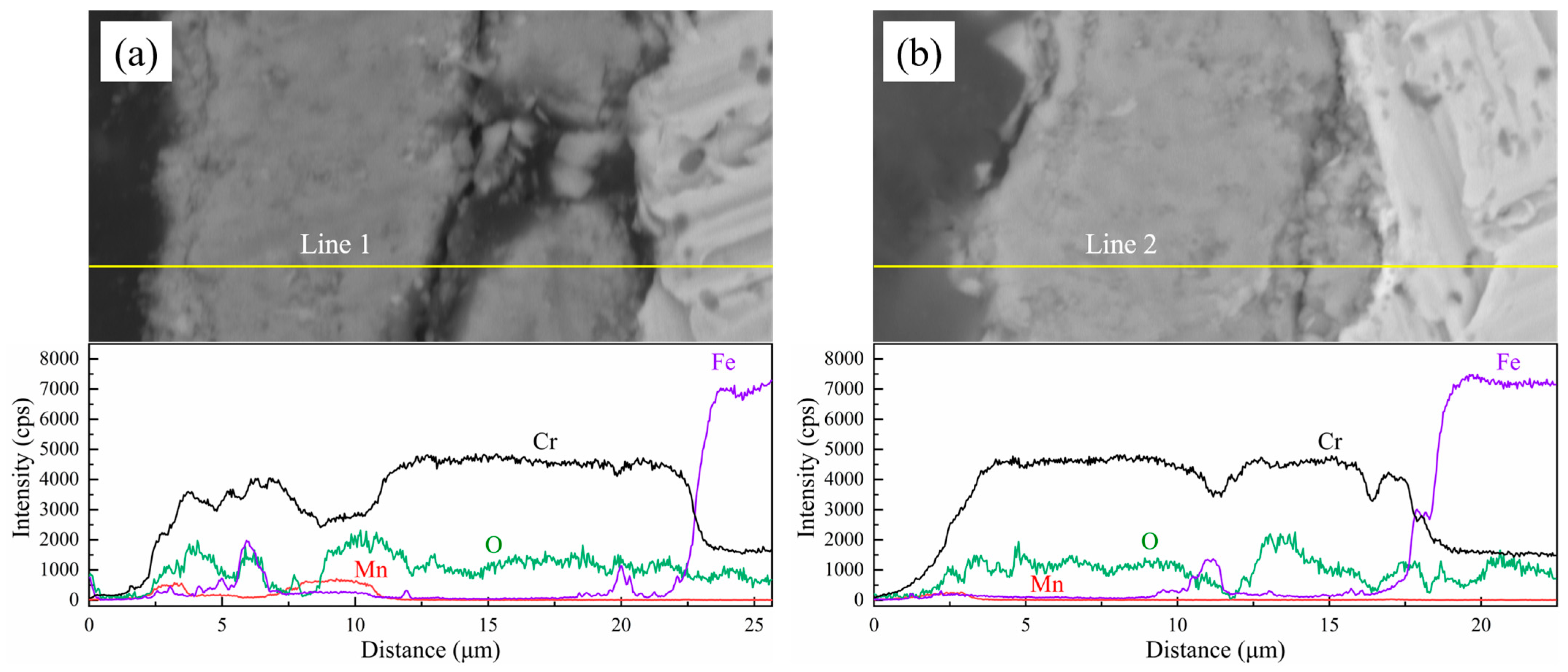
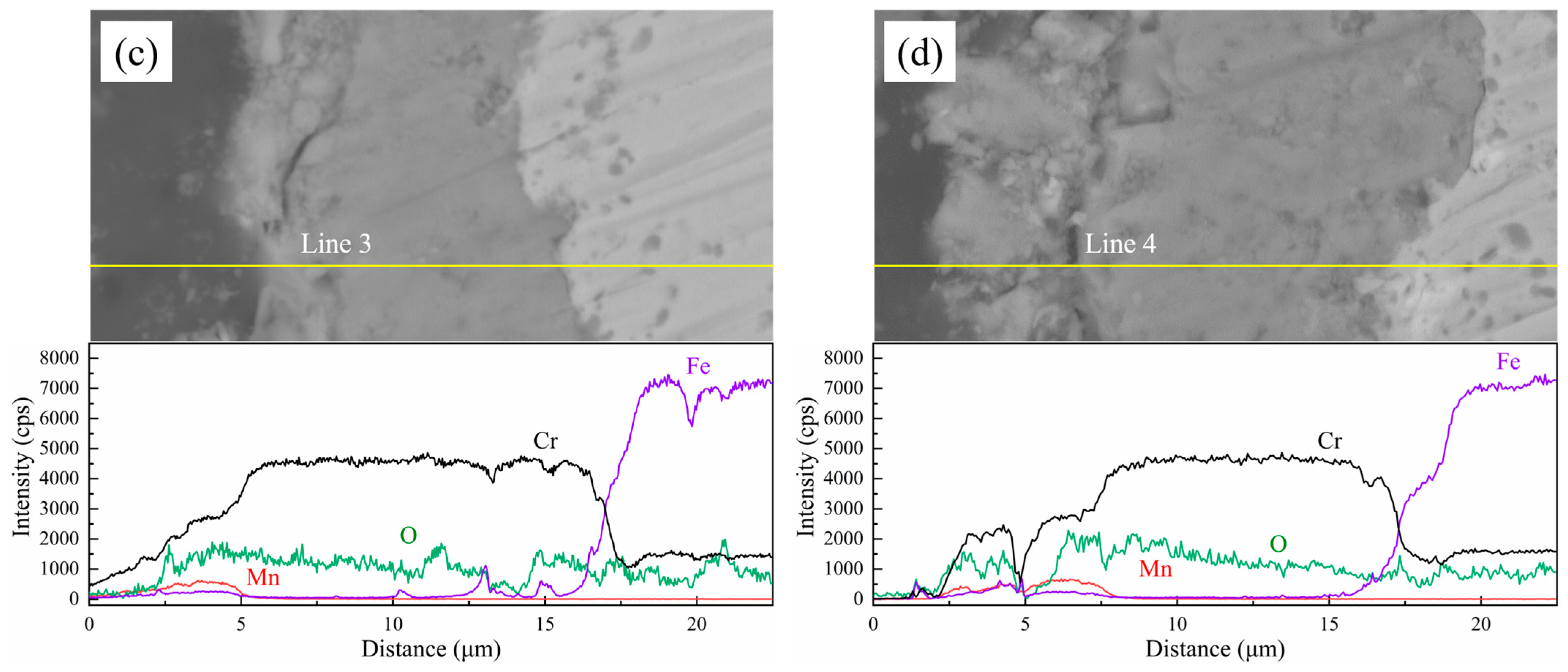

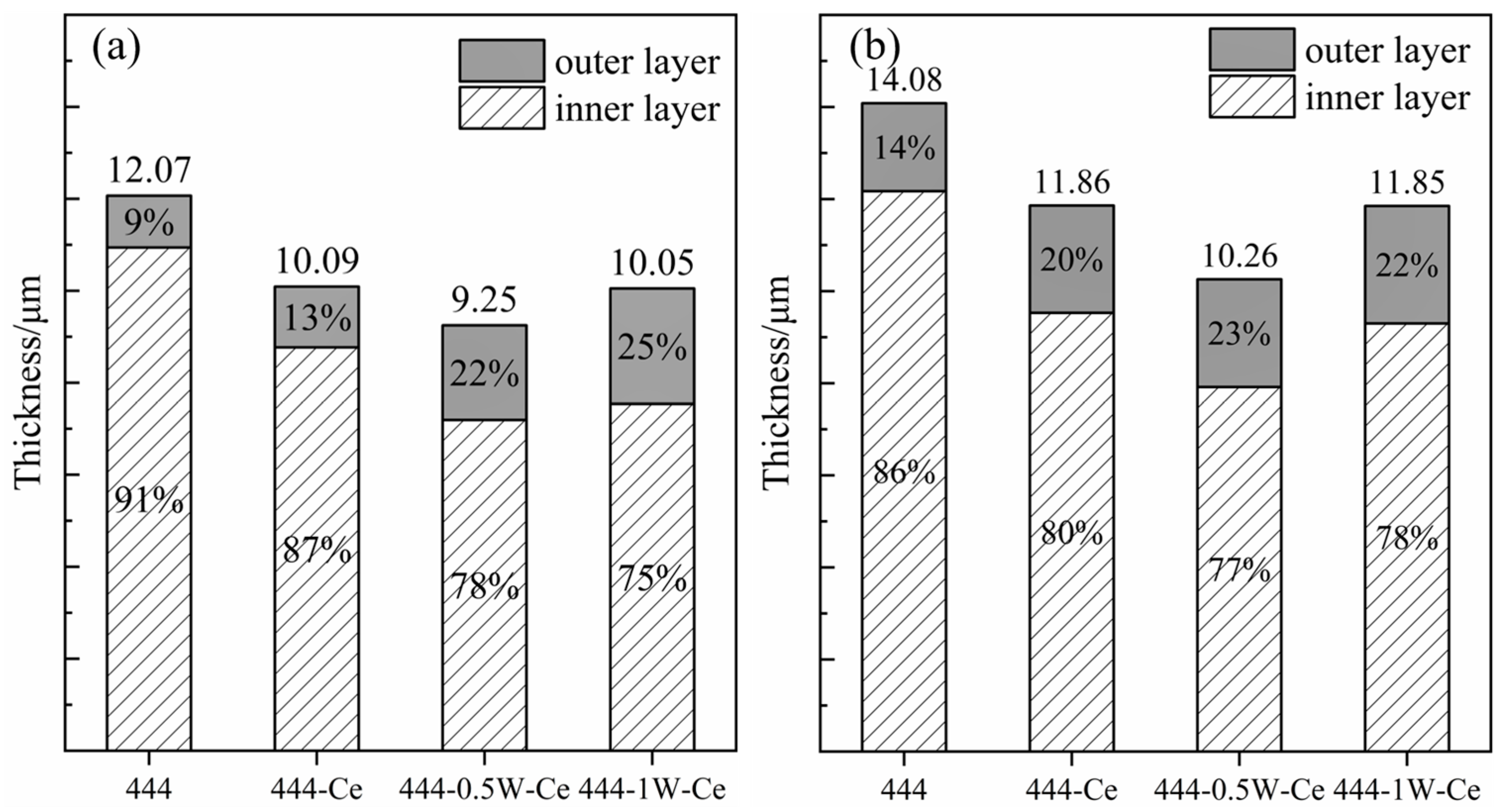

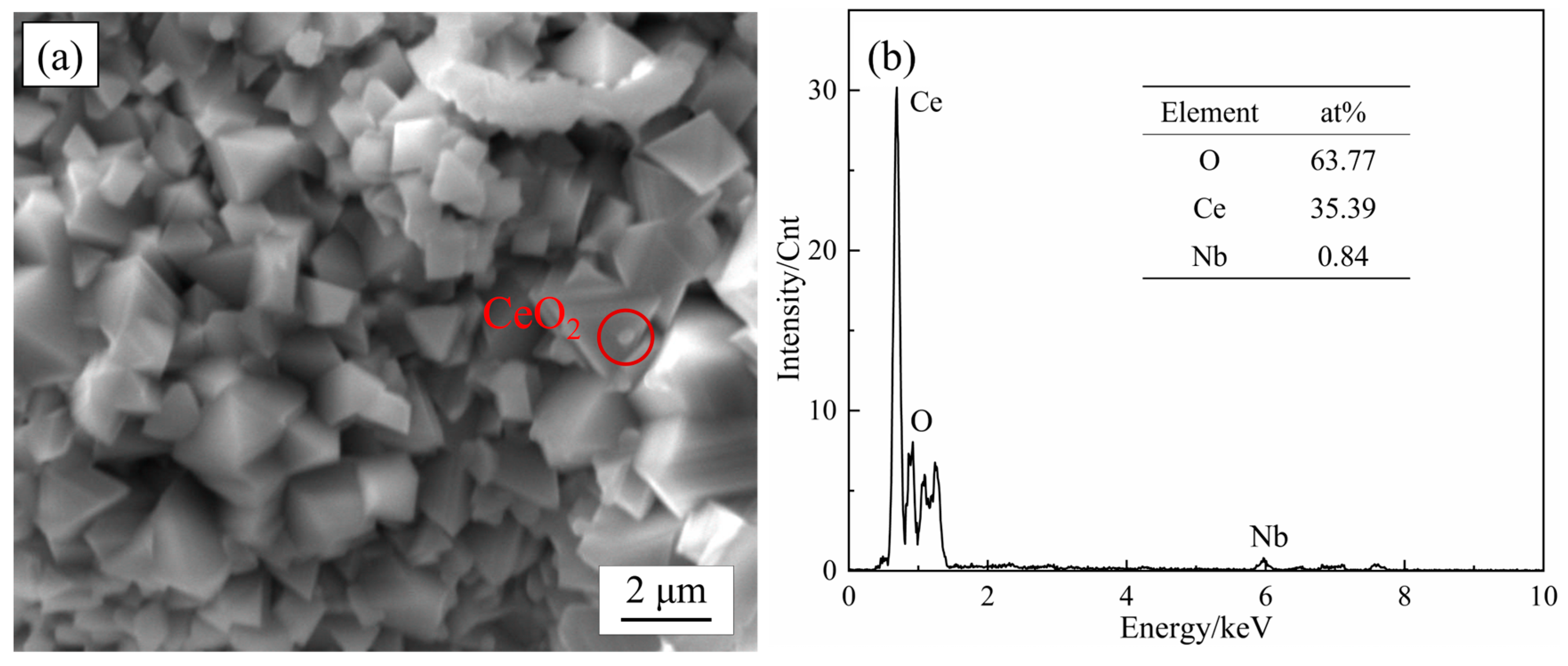
| Steel | C | Mn | N | Cr | Mo | Nb | Ti | Si | W | Ce | Fe |
|---|---|---|---|---|---|---|---|---|---|---|---|
| 444 | 0.006 | 0.33 | 0.008 | 18.43 | 1.82 | 0.436 | 0.174 | 0.54 | – | – | 78.256 |
| 444-Ce | 0.009 | 0.32 | 0.007 | 19.98 | 2.05 | 0.56 | 0.155 | 0.52 | – | 0.048 | 76.351 |
| 444-0.5W-Ce | 0.007 | 0.32 | 0.008 | 19.78 | 1.95 | 0.44 | 0.137 | 0.50 | 0.58 | 0.056 | 76.222 |
| 444-1W-Ce | 0.01 | 0.35 | 0.007 | 19.87 | 2.03 | 0.55 | 0.141 | 0.53 | 1.12 | 0.053 | 75.339 |
| Temperature (°C) | Steel | Kp (mg2∙cm−4∙h−1) |
|---|---|---|
| 950 °C | 444 | 5.19 × 10−3 |
| 444-Ce | 9.38 × 10−4 | |
| 444-0.5W-Ce | 9.05 × 10−4 | |
| 444-1W-Ce | 8.71 × 10−4 | |
| 1050 °C | 444 | 1.87 × 10−2 |
| 444-Ce | 3.07 × 10−3 | |
| 444-0.5W-Ce | 2.76 × 10−3 | |
| 444-1W-Ce | 2.81 × 10−3 | |
| 1100 °C | 444 | 7.53 × 10−2 |
| 444-Ce | 1.63 × 10−2 | |
| 444-0.5W-Ce | 1.84 × 10−2 | |
| 444-1W-Ce | 1.22 × 10−2 | |
| 900 °C | Crofer 22 H [22] | 6.80 × 10−5 |
| 1000 °C (isothermal oxidation) | Crofer 22 APU [23] | 3.71 × 10−4 |
| 900 °C (isothermal oxidation) | 18Cr-Al-Si [24] | 3.41 × 10−4 |
| 950 °C | 441 [25] | 2.16 × 10−3 |
| Temperature (°C) | Steel | Q (kJ∙mol−1) |
|---|---|---|
| 950–1050 °C | 444 | 246 |
| 444-Ce | 279 | |
| 444-0.5W-Ce | 292 | |
| 444-1W-Ce | 281 |
Disclaimer/Publisher’s Note: The statements, opinions and data contained in all publications are solely those of the individual author(s) and contributor(s) and not of MDPI and/or the editor(s). MDPI and/or the editor(s) disclaim responsibility for any injury to people or property resulting from any ideas, methods, instructions or products referred to in the content. |
© 2024 by the authors. Licensee MDPI, Basel, Switzerland. This article is an open access article distributed under the terms and conditions of the Creative Commons Attribution (CC BY) license (https://creativecommons.org/licenses/by/4.0/).
Share and Cite
Zheng, J.; Feng, Y.; Zhao, Y.; Chen, L. High-Temperature Cyclic Oxidation Behavior and Microstructure Evolution of W- and Ce-Containing 18Cr-Mo Type Ferritic Stainless Steel. Materials 2024, 17, 2230. https://doi.org/10.3390/ma17102230
Zheng J, Feng Y, Zhao Y, Chen L. High-Temperature Cyclic Oxidation Behavior and Microstructure Evolution of W- and Ce-Containing 18Cr-Mo Type Ferritic Stainless Steel. Materials. 2024; 17(10):2230. https://doi.org/10.3390/ma17102230
Chicago/Turabian StyleZheng, Jiahao, Yang Feng, Yang Zhao, and Liqing Chen. 2024. "High-Temperature Cyclic Oxidation Behavior and Microstructure Evolution of W- and Ce-Containing 18Cr-Mo Type Ferritic Stainless Steel" Materials 17, no. 10: 2230. https://doi.org/10.3390/ma17102230






